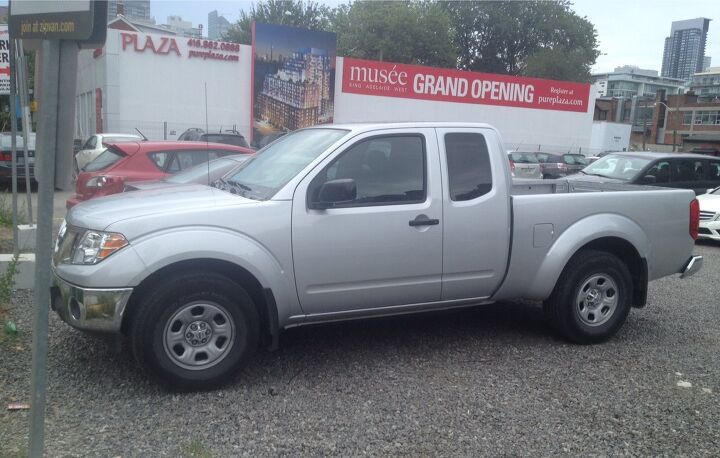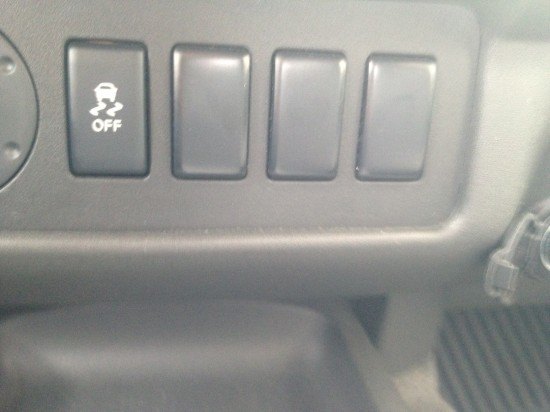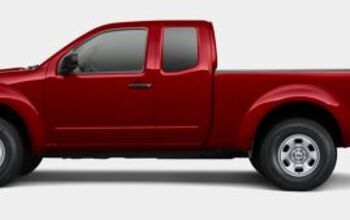Rental Review: 2012 Nissan Frontier S King Cab 4×2
The compact pickup is an endangered species in North America, but the reasons for its demise depend on which camp you ask. Its proponents will tell you that CAFE, the chicken tax and marketing campaigns have all conspired to kill off small trucks. Detractors claim that the new generation of full-size trucks are just as fuel-efficient and affordable, while in many cases being more refined.
I really like pickups, but haven’t had a lot of seat time in them. Hell, it wasn’t that long ago that I mistakenly called the new Ram 1500 a “quarter ton” pickup, with some members of the B&B responding in a manner that made Kohmeni’s fatwa against Salman Rushdie look measured and calm. In keeping with our new mandate to expand TTAC’s rental review program, I decided to work out my Zipcar membership when I needed to haul two sets of R-Compound tires and wheels to the tire shop. And it just so happened that I ended up with what could actually be called a quarter-ton pickup.
For $14.25 per hour or $113 per day (including taxes, insurance, fuel and 120 miles of driving), Zipcar’s Toronto outpost offers you a choice of a Nissan Frontier or a Toyota Tacoma. There is no vague “pickup truck” category that surprises you with the exact model. You can pick your car of choice assuming it’s available at the time you want it. It just so happened that all the Tacomas were booked up, but the Zipcar website showed a Lava Red Frontier Crew Cab SL.
Imagine my surprise when I strolled up to the parking lot (above the fold, situated in the showroom for one of the city’s ubiquitous condo development projects) to see a silver, base model “King Cab”, Nissan’s nomenclature for an extended cab truck. Press fleets never stock such a basic vehicle, so I seized the opportunity to get behind the wheel of a truly basic vehicle.
This Frontier’s sole option was the automatic transmission hooked up to the 2.5L 4-cylinder engine. It had basic creature comforts like air-conditioning, power locks and windows and a tinny sound system, but everything else was decidedly poverty-spec. I can’t remember the last time I’ve seen block-off switches in a new car.
Not that I blame Zipcar for ordering the most basic trim. I’d be hard pressed to think of a car that has gone through a rougher life than a pickup being operated by an urban car sharing service. Those 23,479 km (14,589 miles) are without a doubt some of the hardest ever racked up on any car. But a quick walk-around reveals something disconcerting for such low mileage.
Rust. All over the unlined bed. This car has likely had all sorts of crap mercilessly tossed in the back, and gone through one wretched winter of road salt and associated grime, but I find the notion of surface rust all over the bed (the spots were too numerous to photograph) to be rather disconcerting after such a short service life.
Undettered by the corrosion, I made the 7 mile journey from the lot to my storage area, which necessitated a drive through dense, urban traffic. And you know what? I quite liked the Frontier. The 2.5L 4-cylinder is hardly a model of refinement, and it’s quite eager to rev up and make lots of noise without doing anything, but for this kind of driving, it was perfectly adequate. The ride quality was most surprising: it was hard to unsettle the Frontier. I’ve driven other Japanese full-sizers with far worse ride quality, and NVH for that matter. This truck was quiet, something I noticed because the stereo was so awful that turning it up even one-quarter of the way would immediately make everything sound like a Yoko Ono performance art piece. By far the biggest dynamic letdown were the brakes, which were as firm as a moldy apricot.
Once I finally arrived, I was easily able to fit all 8 wheels into the fairly long bed. Once the rims were separated from the tires, I threw a set on the pitiful jump seats, which are suitable for a house cat at best. It’s hard to imagine any human or canine being comfortable back there for any period of time.
In this setting, the Frontier performed admirably. One might even say its spartan character lent it a bit of charm and I was perfectly satisfied with the way it performed. I can’t say it’s an object of lust for me like a nicely equipped F-Series or RAM 1500 might be, but I’d have no problem renting one again.
The big problem that this and other mid-size trucks face is when customers take a look at actually purchasing one. For the same $22,218 Nissan wants for this exact truck in Canada, you can get a far superior full-size truck. Take Canada’s best-seller, the Ford F-150, for example. Ford is now offering a basic V6 standard cab F-150 XL for just over $18,000, while a 5.0L STX can be had for $19,611 – add another $1000 for the 5.0L V8 and you’re still undercutting the 4-cylinder Frontier with a truck that is undoubtedly a generation ahead of the Frontier. Add 4-wheel drive to the mix and you’re stepping up to the $27,218 Frontier SV V6, while adding it to the STX brings the total to $22,911. Given that the Frontier and F-150’s respective powertrains are within 1-2 mpg of each other, the fuel economy argument becomes moot. And at 205 inches long, this Frontier isn’t exactly the ideal urban truck that people tend to think of when discussing smaller trucks. All this illustrates exactly why mid-size trucks have had such a tough go in the United States (and Canada for that matter). The new full-sizers are better than ever and priced so competitively that it’s tough to make the case for one over a full-size truck. I’ll leave it to the commentariat to make the case. For now I’m not quite convinced.
More by Derek Kreindler
Latest Car Reviews
Read moreLatest Product Reviews
Read moreRecent Comments
- Arthur Dailey We have a lease coming due in October and no intention of buying the vehicle when the lease is up.Trying to decide on a replacement vehicle our preferences are the Maverick, Subaru Forester and Mazda CX-5 or CX-30.Unfortunately both the Maverick and Subaru are thin on the ground. Would prefer a Maverick with the hybrid, but the wife has 2 'must haves' those being heated seats and blind spot monitoring. That requires a factory order on the Maverick bringing Canadian price in the mid $40k range, and a delivery time of TBD. For the Subaru it looks like we would have to go up 2 trim levels to get those and that also puts it into the mid $40k range.Therefore are contemplating take another 2 or 3 year lease. Hoping that vehicle supply and prices stabilize and purchasing a hybrid or electric when that lease expires. By then we will both be retired, so that vehicle could be a 'forever car'. Any recommendations would be welcomed.
- Eric Wait! They're moving? Mexico??!!
- GrumpyOldMan All modern road vehicles have tachometers in RPM X 1000. I've often wondered if that is a nanny-state regulation to prevent drivers from confusing it with the speedometer. If so, the Ford retro gauges would appear to be illegal.
- Theflyersfan Matthew...read my mind. Those old Probe digital gauges were the best 80s digital gauges out there! (Maybe the first C4 Corvettes would match it...and then the strange Subaru XT ones - OK, the 80s had some interesting digital clusters!) I understand the "why simulate real gauges instead of installing real ones?" argument and it makes sense. On the other hand, with the total onslaught of driver's aid and information now, these screens make sense as all of that info isn't crammed into a small digital cluster between the speedo and tach. If only automakers found a way to get over the fallen over Monolith stuck on the dash design motif. Ultra low effort there guys. And I would have loved to have seen a retro-Mustang, especially Fox body, have an engine that could rev out to 8,000 rpms! You'd likely be picking out metal fragments from pretty much everywhere all weekend long.
- Analoggrotto What the hell kind of news is this?





















































Comments
Join the conversation
@Dan We're all just expressing what *we'd* like to have. And I'm sure you can gauge our level of concern for whatever you want/like/do.
I have 2 1984 Nissan 720's, both over 200K, doesn't anybody posting know how to maintain a vehicle?